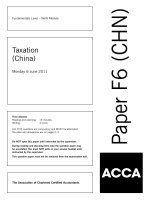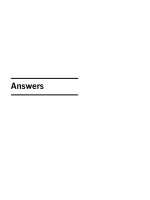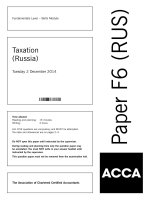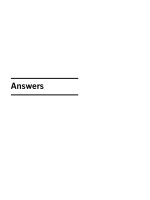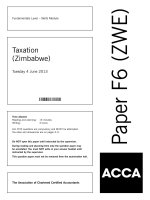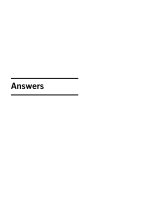ACCA f6 taxation south africa 2014 jun answer
Bạn đang xem bản rút gọn của tài liệu. Xem và tải ngay bản đầy đủ của tài liệu tại đây (197.96 KB, 8 trang )
Answers
Fundamentals Level – Skills Module, Paper F6 (ZAF)
Taxation (South Africa)
June 2014 Answers
and Marking Scheme
Marks
1
Harry’s Car Wash and Panelbeaters (Pty) Ltd
(a)
Settlement payments and repair costs
For the settlement payments and repair costs to be deductible, the amount must be expenditure actually incurred
in the production of income, other than an amount of a capital nature.
1
The specific ‘repairs’ deduction is inapplicable as the repairs performed were not on assets used by the taxpayer
in the course of its trade. The general deduction rule (as above) must therefore be followed.
1
In the case of the settlements paid and repairs completed, it is clear that the amounts have been incurred and
are therefore ‘actually incurred’ for the purpose of the general deduction rule. The amount of R25,000 in claims
is simply a provision and is not yet actually incurred with the result that such R25,000 will not be deductible
in the 2014 tax year.
2
In establishing whether or not such settlement amounts and repairs conducted are in the production of income,
the taxpayer will have to assess whether or not the risk of such an event was an inevitable concomitant of the
business or was the result of gross negligence. If the latter is shown to be true, the amount will not be
deductible. If the former is true, then the associated risk and payment linked to such risk may be considered to
be in the production of income.
The settlements and repairs arise directly from the services rendered by the employees. The nature of the
business requires the regular moving of customer vehicles and as such it is an inevitable risk that damage might
occur. These costs are therefore submitted to be of a revenue nature and in the production of income.
15
1
½
½
2
–––
8
–––
Marks
(b)
Income tax liability for the 2014 year of assessment
R
Fee income
Interest income
Parking ticket charges
Insurance policy compensation income
Settlements and repairs to customer vehicles (70,000 + 30,000)
Recoupment of allowances on compressor:
Insurance proceeds
Limited to cost price
Less tax value R400,000 – R400,000 x 100% (allowances
claimed in year of acquisition)
Recoupment to be deferred
Tutorial note: No allowance for the compressor in the current year as it
would have been fully written off in the year of acquisition.
Capital gain or capital loss:
Proceeds
Less recoupment
Less base cost:
Expenditure less allowances permitted (R400,000 – R400,000)
Capital gain to be deferred
Tutorial note: It is important to note that the deferral mechanism for the
recoupment is reliant on a capital gain arising or a nil value arising on the
disposal of the previous asset.
Allowance on replacement machine: R530,000 x 100%
Recognised portion of recoupment of old machine: 100% x R370,000
Tutorial note: While deferral is chosen, the deduction is permitted in full
negating any deferral.
Repairs to the spray booth: deductible in full (specific deduction permitted
despite capital nature of expenditure) reduced by the insurance proceeds
received, i.e. R380,000 less R150,000
Pressure cleaning hoses: Year 3: 20% x R140,000
Tutorial note: For assets not used in a process of manufacture, small
businesses have the option of claiming an allowance as 50:30:20 (over
three years) or in terms of Binding General Ruling number 7. In this case,
the accelerated allowance is better.
Motorised polishing tools: Year 2: 30% x R180,000
Tutorial note: No allowance for the pressure paint spray nozzles as these
would have been fully written off in the prior year.
Consumables purchased: (R1,900,000 + R350,000 – R450,000)
Opening stock
Closing stock (at written down value)
Marking note: The 2 marks will also be awarded if the candidate simply
uses the R1,900,000 effect but does not include the opening and closing
stock figures.
Rental expense: Current year payment (1 June 2013): R450,000
Tutorial note: The rental payment extends over a period of less than six
months after the end of the year of assessment, so a full claim is made in
the year the expense is incurred.
Doubtful debts: Current year: R3,000 x 25%
Reversal of prior year allowance: R4,000 x 25%
Bad debts written off
Other tax deductible expenses – given
Capital gain from deferral to be recognised:
Sum of current year capital gains and capital losses
Net capital gain
Taxable capital gain inclusion: 66·6% x R300,000
R
12,500,000
500,000
(175,000)
1,000,000
(100,000)
370,000
––––––––
400,000
½
½
(0)
370,000
––––––––
1
370,000
(370,000)
––––––––
0
½
½
(0)
––––––––
0
––––––––
1
(530,000)
370,000
½
1
(230,000)
(28,000)
1
1
(54,000)
1
(1,800,000)
(450,000)
350,000
1
½
½
(450,000)
1
(750)
1,000
(1,000)
(7,150,000)
1
1
1
½
1
0
––––––––
300,000
––––––––
300,000
––––––––
199,800
–––––––––––
3,952,050
–––––––––––
Taxable income
16
½
½
½
½
1
1
Marks
R
Tax: Small business corporation (SBC) rates: R59,702 + 28% x
(R3,952,050 – R550,000)
Less provisional tax
Normal tax owing
2
1,012,276
(800,000)
––––––––
212,276
––––––––
1
1
–––
22
–––
30
–––
Mrs Samantha Parker
(a)
Employees tax withheld and paid for the 2014 year of assessment
Cash salary R25,000 x 8
Employer’s contribution to the pension fund
Tutorial note: An employer’s contribution to a pension fund is not a fringe benefit, nor
is it deductible as it is not incurred by the employee.
Use of the computer and data card
Tutorial note: The use of the computer and data card is a fringe benefit, being the right
of use of an asset, but the valuation provision indicates that such use carries no value.
Travel allowance: less than 80% business travel (12,000 kms + 8,000 kms +
2,000 kms)/39,000 kms:
Inclusion for employees tax therefore: 80% x R2,000 x 8
Medical contributions paid by employer R3,500 x 8 (no reduction for disability)
Balance of remuneration excluding annual amounts
Annual equivalent of monthly amounts: R240,800 x 12/8
Add annual amount: resignation bonus
Total balance of remuneration
Tax on R411,200 per the tables: R82,904 + 35% (411,200 – 358,110)
Less primary rebate (under 65)
Less medical contribution rebate:
[R646 (member plus two dependants)] x 12
Tax liability for total annual equivalent
R
200,000
0
½
½
0
1
12,800
28,000
––––––––
240,800
––––––––
361,200
50,000
––––––––
411,200
––––––––
1½
1
101,485
(12,080)
½
½
(7,752)
––––––––
81,653
––––––––
1
83,985
(12,080)
½
½
(7,752)
––––––––
64,153
––––––––
½
42,769
17,500
––––––––
60,269
––––––––
½
½
1
1
Tutorial note: While the contributions to the medical aid ceased at the end of October, for
employees tax calculations all effects are considered to last for the full 12 months to get the
correct withholding.
Tax on R361,200 per the tables: R82,904 + 35% (361,200 – 358,110)
Less primary rebate (under 65)
Less medical contribution rebate:
[R646 (member plus first dependant)] x 12 months
Employees tax on ‘monthly’ amounts – R64,153 x 8/12
Add tax on annual amounts: R81,653 – R64,153
Employees tax withheld and paid to SARS
17
–––
11
–––
Marks
(b)
Normal tax liability for the 2014 year of assessment
R
Employment
Balance of remuneration excluding annual amounts
Resignation bonus
Less travel allowance for employees tax purposes
Other income
Interest
Less interest exemption (max R23,800 for persons under 65)
Foreign dividends
Less general foreign dividend exemption: 25/40 x R7,000
240,800
50,000
(12,800)
32,000
(23,800)
––––––––
7,000
(4,375)
––––––––
Contribution to retirement annuity fund:
Actual – R36,000
Limited to greater of: R1,750; or
R3,500 – R0; or
15% x (R288,825 – R200,000) (non-retirement
funding income) = R13,324
Add travel allowance: R2,000 x 8 months
Reduced by better of actual expenditure or deemed expenditure:
Actual expenditure:
Wear and tear: R437,000/7 years
Fuel
Maintenance
Reduction: (12,000 + 8,000 + 2,000)/39,000 kms x R118,429
Therefore allowance would be reduced to nil.
Deemed expenditure:
Fixed cost: R118,078/39,000 kms
302·8c
Fuel
147·7c
––––––––
450·5
––––––––
Tutorial note: No maintenance is added as the employee is not responsible
for full maintenance.
Business kms: 22,000 kms x 450·5c
Both options reduce allowance to nil.
Inclusion
Less medical deduction:
Employee contributions (actual and deemed) R3,500 x 8
Reduced by 4 x 8/12 of rebate of R7,752 (see part (a))
Qualifying contributions
Add other qualifying medical expenses:
Additional costs incurred
Deduction (as a result of disabled husband)
Taxable income
Tax per the tables: R53,096 + 30% (266,173 – 258,750)
Less primary rebate (under 65)
Less medical rebate: 8/12 x R7,752 (from part (a))
Total normal tax
Less employees tax (from part (a))
Refund due
18
R
8,200
2,625
––––––––
288,825
½
½
½
½
½
½
½
½
(13,324)
––––––––
275,501
1
16,000
½
62,429
48,000
8,000
––––––––
118,429
––––––––
66,806
½
½
½
99,110
1
1
0
––––––––
275,501
––––––––
½
28,000
(20,672)
––––––––
7,328
½
1
2,000
––––––––
½
(9,328)
––––––––
266,173
––––––––
½
55,323
(12,080)
(5,168)
––––––––
38,075
(60,269)
––––––––
22,194
––––––––
½
½
½
½
–––
14
–––
25
–––
Marks
3
Joe Ncgobo – Taxable capital gain on January 2014 disposal
R
Proceeds
Base cost:
Valuation date value:
Market value on 1 October 2001 (given)
20% x (Proceeds less post-valuation date qualifying
expenditure) 20% x (R17,200,000 – R900,000 –
R550,000 – R950,000 – R560,000)
Time apportioned base cost:
B = R3,400,000 + R243,000 + R55,000
A = R560,000 + R950,000 + R550,000
R = R17,200,000 – R900,000 (selling costs)
Therefore: P = R x B/(B + A) =
N=
T=
Time apportioned base cost:
Y = B + ((P – B) x N)/(T + N)
Choose market value
Post-valuation date expenditure: A + R900,000
Total months owned after 2001
Portion of gain to be set against primary residence:
R8,840,000 x 32/147·5 + R8,840,000 x 98% x 115·5/147·5
Less primary residence exclusion
Add business use portion of capital gain:
R8,840,000 x 2% x 115·5/147·5
Total capital gain
Capital gain
Less annual exclusion
2,848,000
3
3,698,000
2,060,000
16,300,000
10,468,461
3
13
1
1
1
1
½
½
1
4,967,461
(5,400,000)
(2,960,000)
–––––––––––
8,840,000
–––––––––––
32
115·5
––––––
147·5
––––––
Taxable capital gain: R6,810,000 x 33·3%
Tax at 40%
19
½
1
1
1
8,701,557
(2,000,000)
138,443
–––––––––––
6,840,000
–––––––––––
6,840,000
(30,000)
–––––––––––
6,810,000
–––––––––––
Aggregate and net capital gain
1
5,400,000
Capital gain before primary residence exclusion
Months property 100% primary residence: 2 years + 8 months
Months property 98% primary residence: 9 years + 7·5 months
R
17,200,000
2
1
2
½
2,267,730
–––––––––––
½
907,092
½
–––
20
–––
Marks
4
Cheap Tours and Transport (Pty) Ltd
(a)
Deregistration for value added tax (VAT)
A business may request SARS to cancel its VAT registration if the taxable supplies made in a period of 12 months
falls below R1 million, or if all business activities have ceased.
The business is required to complete the cancellation of registration form and submit the form to the local SARS
branch.
(b)
1
–––
3
–––
Input/output VAT effects of transactions
Input
VAT
R
(i)
(ii)
(iii)
(iv)
(v)
(vi)
(vii)
(viii)
(c)
2
Tours sold – 100% of the tours are a VATable supply at the
standard rate: R12,000,000 x 14/114
SA transport – exempt supply
Transport to location outside SA – zero rated
Payments for South African lodge accommodation at the
standard rate: (R3,000,000 – R1,200,000) x 14 /114
Payments for non-SA accommodation (not within the Republic)
Bad debts written off result in a reversal of the output VAT –
R40,000 x 14/114
This bus is a motor car, so the VAT input is denied
No input can be claimed on the SUV as the vehicle is a motor car
as defined for VAT purposes and the input is therefore denied.
The SUV for the managing director results in output VAT on
the fringe benefit, being: R570,000 x 14/114 x 0·3% x 2 months
The pool table is considered entertainment and the input is denied.
The server operates the entire business’s IT (i.e. is used for the
making of both exempt and taxable supplies): R25,000 x
14/114 x 60%
Output
VAT
R
0
0
1,473,684
1
½
½
221,053
0
1
1
4,912
0
1
1
0
1
420
0
1,842
––––––––
227,807
––––––––
––––––––––
1,474,104
––––––––––
The VAT payment due to SARS for the VAT period May to June 2014 is R1,246,297.
The VAT return must be filed by the last business day of the month following the end of the VAT period.
Payment (if due) must be made by the same date.
1
1
1
–––
10
–––
½
1
½
–––
2
–––
15
–––
Tutorial note: Payment means that the amount must have been cleared in the SARS bank account.
5
Theoretical questions
(a)
The following are required to keep records, books of account, etc, with respect to a tax period:
A person who has submitted a return for the tax period.
1
A person who is required to submit a return but did not submit such return.
1
A person not required to submit a return, but who has received income, has a capital gain or capital loss or has
engaged in an activity which is subject to tax or would be subject to tax but for the application of a threshold
or exemption.
20
1
–––
3
–––
Marks
(b)
The types of assessment which may be issued are:
An original assessment – issued based on the return submitted by the taxpayer or other information available or
obtained in respect of the taxpayer.
1½
An additional assessment – issued if the assessment does not correctly reflect the application of the tax acts,
SARS must raise an additional assessment.
1½
A reduced assessment – if there is a dispute, settlement or judgement in favour of the taxpayer or SARS is
satisfied that there is an error in the assessment.
1½
A jeopardy assessment – is issued if SARS believes that there is an urgent need to secure the collection of the
tax owing.
Marking note: A ½ mark for identifying/naming the assessment and 1 mark for the explanation, per item.
(c)
Any person who provides advice to another person in respect to the application of a tax act or who completes
or assists in the completion of a return by another person.
21
1½
–––
6
–––
1
–––
10
–––
